
Amazon Echo Dot vs. Google Home Mini: Which Should You Get?
Both the Amazon Echo Dot and the Google Home Mini represent affordable ways to try a smart speaker in your home. Using nothing but your voice, you can ask both to play music, get news updates, set timers, and control popular smart-home devices. They can also answer an ever-increasing variety of questions. If you’re shopping for your first smart speaker, we think the Echo Dot is a slightly better value, but a lot of “it depends” concerns are involved in that recommendation.
The biggest difference between the Echo Dot and the Home Mini are the platforms that enable them to work their magic. The Echo Dot runs on Amazon’s Alexa platform, and the Home Mini runs on Google Assistant. If you already own devices that support either platform, the decision is easy: Stick with the platform you already chose, because these things work better in groups. Whether that’s the ability to play the same song or podcast simultaneously in multiple locations (a feature called multiroom audio) or the ability to serve as a home intercom system, the more the merrier.
If you haven’t picked a platform yet, we go into more detail on the platforms individually in our Echo vs. Google Home speaker comparison to help you decide. In that guide, you’ll find more information on which streaming services and smart-home ecosystems are supported by which platform, as well as how the platforms compare at answering questions. Here we expand a bit more on how the devices themselves compare with each other.
All the benefits of the larger Echo, but with a smaller speaker and a smaller price. It's also an easy way to add an intercom system to your home.
Buying Options
A cheap way to test out Google Assistant in your home, especially if you like asking questions.
We think more people may like the softer, rounded look of the Home Mini more than the Echo Dot, though neither is something to set in the middle of your dining room table. Both are the size of a hockey puck. The Echo Dot comes in white or black, while the Home Mini comes in white/light gray, dark gray, or red/orange with matching fabric covers. At best, they disappear into the background equally until they light up upon hearing their names.
While you primarily control both smart speakers via voice, you have other ways of interacting with the devices. Amazon made the Echo Dot a little easier to use than previous models by adding actual buttons on the top, so even someone new to the device will be able to figure out how to turn off the microphone or control the volume. The Home Mini also lets you control it by tapping, but the device has no obvious visible buttons, so you have to know what you’re doing. This may not be important after you’ve lived with the Home Mini for a while, but the knowledge is helpful when guests come over.
The Home Mini’s larger and louder speaker beats that of the Echo Dot in out-of-the-box sound quality—although to be fair, they both sound pretty terrible on their own as music devices. If you expect to use your smart speaker primarily for listening to music, you’re better off upgrading to the larger and better-sounding Amazon Echo or full-size Google Home. Either of those models would work well as an office or kitchen speaker because both have good enough sound quality and are clearly audible from across the room.
Alternatively, if you already have a set of speakers you like, the Echo Dot is the better option because it can connect wirelessly to any Bluetooth speaker. It also has a 3.5 mm output jack to connect to a non-wireless audio system with a cable. I have one wired into my home theater receiver, which plays through a 7.2 speaker system. A recent update also allows any Alexa device to control any existing Sonos speakers you might have (although this feature doesn’t support all music services, which we touch upon in our Sonos One review).
The Home Mini does not offer Bluetooth output, nor does it have a wired audio-output option. However, if you have a Chromecast speaker, such as the JBL Playlist, or Chromecast Audio dongles connected to a sound system, you can cast the Home Mini’s sound output to that speaker via Wi-Fi. Casting (that is, streaming via Chromecast) is better than nothing, but it’s not as commonplace as using Bluetooth or a cable.
If you’re interested in smart home control, find out which system the devices you already own will work with. For instance, if you have Philips Hue or LIFX lights, or Wemo or Lutron Caséta switches, you can go either way. If you have a Chamberlain MyQ garage-door controller, you’re looking at a Google Home. Have a Kwikset Kevo door lock? You should choose Amazon Alexa. For a more complete rundown of how the systems stack up, check out our full guide.
One last thing to consider is accessories. You can find more third-party accessories for the Amazon Echo Dot than for the Google Home Mini. You can get battery backups, speaker boosters, and decorative skins all designed to fit the Echo Dot, largely because the Echo Dot has been available for longer and (according to an Edison/NPR research report) is more popular than the Home Mini, though you can find a few wall mounts for the Home Mini. We hope this will even out soon, but as of now the Echo Dot has a wider range of accessory options.
Updated on February 5, 2018, to add information on Google Home Mini accessory wall mounts.
Further reading
The Best Stereo Amplifiers and Receivers Under $300
by Brent Butterworth
Stereo amplifiers come in various flavors. We have affordable picks for full-featured integrated amps, discreet mini amps, and powerful stereo receivers.
Smart Home for Apartments and Renters
by Grant Clauser
These smart-home devices don’t need permanent installation, so you can take them with you when you move.
Should You Get a Smart Speaker or a Bluetooth Speaker?
by Brent Butterworth
The choice between a smart speaker and a Bluetooth speaker depends on your lifestyle and your listening habits.
Amazon Sidewalk Will Share Your Internet With Strangers. It’s Not As Scary As It Sounds.
by Jon Chase
Amazon’s new Sidewalk service may make your smart devices smarter—but at the cost of privacy. Here’s what you need to know and how to opt out if you prefer.





